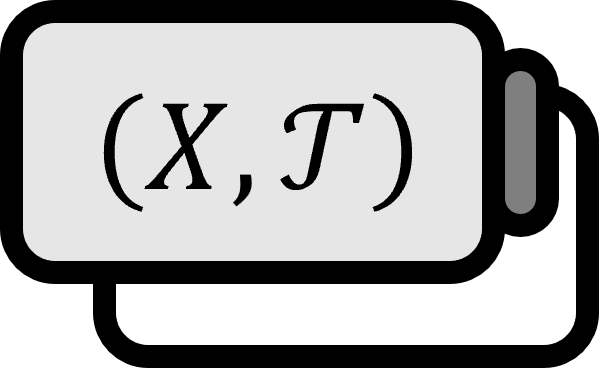Separation Properties in Topology
Definition 1
Let’s consider $X$ as a topological space. For $a,b \in X$, if $a \ne b$ and $U, V \subset X$ are open sets in $X$, then:
- $T_{0}$: If there exists $U$ that contains only one of $a$ and $b$, then $X$ is called a Kolmogorov space.
- $T_{1}$: For any $a,b$, if there exists $U,V$ satisfying $$ a \in U, b \notin U \\ a \notin V, b \in V $$, then $X$ is called a Frechet space.
- $T_{2}$: For any $a,b$, if there exists $U,V$ satisfying $$ a \in U, b \in V \\ U \cap V = \emptyset $$, then $X$ is called a Hausdorff space.
- $T_{3}$: If $X$ is a $T_{1}$-space, and for every closed set $C \subset X$ that does not contain $a$, if there exists $U,V$ satisfying $$ a \in U , C \subset V \\ U \cap V = \emptyset $$, then $X$ is called a Regular space.
- $T_{4}$: If $X$ is a $T_{1}$-space, and for two closed sets $A, B \subset X$ with $A \cap B = \emptyset$, if there exists $U,V$ satisfying $$ A \subset U , B \subset V \\ U \cap V = \emptyset $$, then $X$ is called a Normal space.
Explanation
These properties, also known as Separation Axioms, focus exactly on dividing the space into parts. The classification shown as $T_{i}$ is called Kolmogorov classification. Just by looking at the definitions, you might feel like it’s $$ T_{4} \implies T_{3} \implies T_{2} \implies T_{1} \implies T_{0} $$, and indeed it is, making it a nice classification method.
Especially, $T_{2}$, the Hausdorff space, often becomes a central subject of interest, as its conditions are neither too many nor too few, making it an appropriately usable level. Various bizarre spaces that are commonly used as counterexamples often fail to satisfy $T_{2}$. Examples of non-Hausdorff spaces include Sierpiński space and Indiscrete space.
Following are some useful properties of Hausdorff spaces. It goes without saying that there are many applications since every metric space is a Hausdorff space.
Theorems
- [2-1]: $T_{2}$ is a topological property.
- [2-2]: $T_{2}$ is a hereditary property.
- [2-3]: [In a $T_{2}$-space, a sequence $\left\{ x_{n} \right\}$ converges to at most one point.](../456)
Proof
[2-1]
Assume there exists a homeomorphism $f : X \to Y$ and $X$ is a Hausdorff space. To prove that $Y$ is also a Hausdorff space, it is sufficient to show the following.
$f$ is a bijection, so for two distinct $y_{1}, y_{2} \in Y$, there are two distinct $x_{1}, x_{2} \in X$ satisfying $$ a = f(x_{1}) \\ b = f(x_{2}) $$. By assumption, since $X$ is a Hausdorff space, there exists open sets $U, V \subset X$ satisfying $$ x_{1} \in U \\ x_{2} \in V \\ U \cap V = \emptyset $$. Since $f$ is an open function due to continuity, $f(U)$ and $f(V)$ are open sets in $Y$, and $$ a \in f(U) \\ b \in f(V) \\ f(U) \cap f(V) = \emptyset $$ follows. Therefore, $Y$ is a Hausdorff space.
■
Munkres. (2000). Topology(2nd Edition): p195. ↩︎
